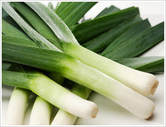|
Ozark Green Thumb BCMG Monthly e-Newsletter |
|
|
 Almost any time of year is good for growing leeks, the most upright members of the onion family. Summer leeks are fast to grow from seed started indoors in late winter, or you can start leek seedlings in late summer to grow from fall to spring. This guide also includes descriptions of the types of leeks to try. Easy to grow and welcome in any recipe that calls for onions, leeks (Allium ampeloprasum var. porrum) allow you to grow oniony crops all year in your kitchen garden. Summer leeks are ready to pull only 60 days after planting, weeks before bulb onions are ready. Slower-growing leek varieties reach maximum size in fall and early winter. Leeks grow best in cool climates, or you can grow them as a fall-to-spring crop where summers are hot. Growing leeks requires moist, fertile soil with a pH between 6.0 and 7.0. Winter leeks tolerate more cold than other varieties, so they are good choices for growing leeks through winter. Mature plants can be left in the ground into winter, or you can sow seed in midsummer for transplanting in early fall. These plants will mature in spring. Under good conditions, the shanks of winter leeks such as ‘Bandit,’ ‘Blue Solaise’ and ‘Siegfried’ exceed 1 inch in diameter. Summer leeks are fast to germinate and grow, though they do not get as large as winter leeks. Maturing 90 days from seeding, or 60 days after transplanting, varieties such as ‘Lincoln,’ ‘King Richard’ and ‘Megaton’ can be grown at close spacing, and pulled anytime after they reach pencil size. Autumn leeks include varieties that mature 100 days from seeding, or 80 days after transplanting. Large and vigorous, varieties such as ‘Lancelot’ and ‘Tadorna’ produce leeks of exceptional quality to harvest in fall, after the weather has cooled. Start leek seeds indoors in late winter provided you can grow them under bright florescent lights. You may also be able to purchase leek seedlings as garden centers or farmers markets in late spring. Harden off seedlings for at least a week before transplanting them to prepared furrows in deeply dug garden beds. Shape 6-inch deep furrows in the cultivated bed, and line the bottom with a standard application of a balanced organic fertilizer. Refill 1 inch of soil, and set out the leek seedlings in the partially refilled furrow, spacing summer leeks 3 inches apart, fall leeks 4 inches apart and winter leeks 6 inches apart. As the leeks gain size, gradually fill in the furrow and then mound a little loose soil over the base of the plants. Keep leeks carefully weeded, and drench plants with a liquid organic fertilizer when they are 15 inches tall. In dry climates, mulch leeks with grass clippings, chopped leaves or another organic mulch that helps retain soil moisture. Leeks need more water than other garden crops, and should never be allowed to run dry. Use a digging fork to loosen soil around leeks before pulling them as needed in the kitchen. Trim roots to one-half inch, and cut off all but 2 inches of the green tops. Store in plastic bags in the refrigerator for up to two weeks. Before eating, slice leeks lengthwise and rinse under cool running water to remove bits of soil. Excess leeks are easy to dry in a food dehydrator. Leeks that have been exposed to cold winter weather produce flowers in early summer, with ripe black seeds about a month later. When the flower heads dry to tan and the seed covers begin to split, gather the seed heads in a paper bag, and allow them to dry indoors for a week. When thoroughly dry, shatter the seed heads and collect the largest seeds for replanting. Under good conditions, leek seeds will store up to three years. Source: Barbara Pleasant: Mother Earth News
1 Comment
|
Archives
April 2022
|
|
